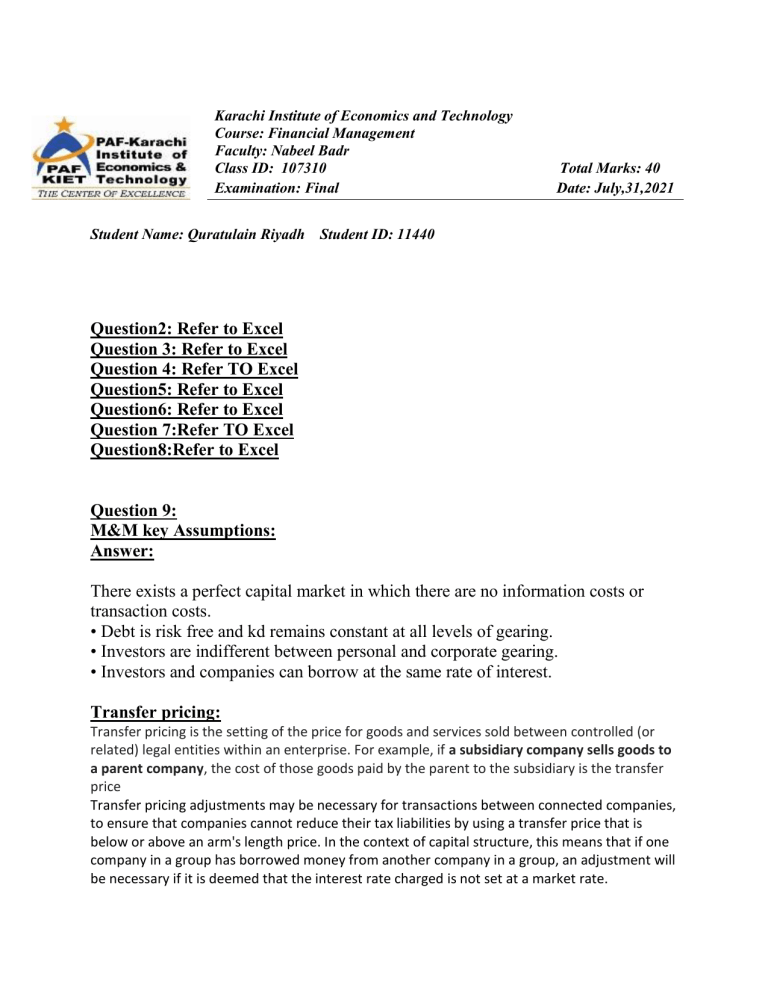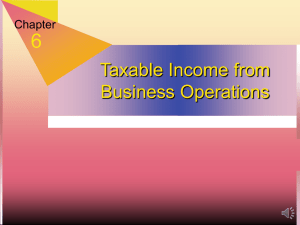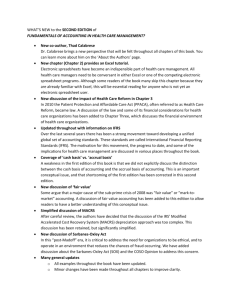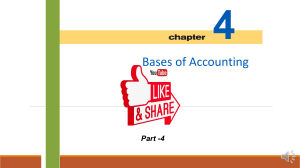
Karachi Institute of Economics and Technology Course: Financial Management Faculty: Nabeel Badr Class ID: 107310 Examination: Final Student Name: Quratulain Riyadh Total Marks: 40 Date: July,31,2021 Student ID: 11440 Question2: Refer to Excel Question 3: Refer to Excel Question 4: Refer TO Excel Question5: Refer to Excel Question6: Refer to Excel Question 7:Refer TO Excel Question8:Refer to Excel Question 9: M&M key Assumptions: Answer: There exists a perfect capital market in which there are no information costs or transaction costs. • Debt is risk free and kd remains constant at all levels of gearing. • Investors are indifferent between personal and corporate gearing. • Investors and companies can borrow at the same rate of interest. Transfer pricing: Transfer pricing is the setting of the price for goods and services sold between controlled (or related) legal entities within an enterprise. For example, if a subsidiary company sells goods to a parent company, the cost of those goods paid by the parent to the subsidiary is the transfer price Transfer pricing adjustments may be necessary for transactions between connected companies, to ensure that companies cannot reduce their tax liabilities by using a transfer price that is below or above an arm's length price. In the context of capital structure, this means that if one company in a group has borrowed money from another company in a group, an adjustment will be necessary if it is deemed that the interest rate charged is not set at a market rate. Cash conversion cycle: The Cash Conversion Cycle (CCC) is a metric that shows the amount of time it takes a company to convert its investments in inventory to cash. The conversion cycle formula measures the amount of time, in days, it takes for a company to turn its resource inputs into cash. Cash Conversion Cycle = DIO + DSO – DPO Where: DIO stands for Days Inventory Outstanding DSO stands for Days Sales Outstanding DPO stands for Days Payable Outstanding THE CAPITAL BUDGETING PROCESS; The budgeting process is the process of putting a budget in place. This process involves planning and forecasting, implementing, monitoring, and controlling, and finally evaluating the performance of the budget. A budget is essential for any organization. It helps to keep track of its income and expenditure. • Generate investment proposals consistent with the firm’s strategic objectives. • Estimate after-tax incremental operating cash flows for the investment projects. • Evaluate project incremental cash flows • Select projects based on a value-maximizing acceptance criterion. • Reevaluate implemented investment projects continually and perform post audits for completed projects Incremental Cash Flow Incremental cash flow is the additional operating cash flow that an organization receives from taking on a new project. A positive incremental cash flow means that the company's cash flow will increase with the acceptance of the project. A positive incremental cash flow is a good indication that an organization should invest in a project. Incremental cash flow is the potential increase or decrease in a company's cash flow related to the acceptance of a new project or investment in a new asset. Positive incremental cash flow is a good sign that the investment is more profitable to the company than the expenses it will incur. Incremental cash flow can be a good tool to assess whether to invest in a new project or asset, but it should not be the only resource for assessing the new venture Accurial vs cash ACCOUTING; Accrual accounting is one of two accounting methods. the other is cash accounting. Accrual accounting measures a company's performance and position by recognizing economic events regardless of when cash transactions occur, whereas cash accounting only records transactions when payment occurs. Accrual accounting is an accounting method where revenue or expenses are recorded when a transaction occurs rather than when payment is received or made. The method follows the matching principle, which says that revenues and expenses should be recognized in the same period. Cash accounting is the other accounting method, which recognizes transactions only when payment is exchanged Accrual accounting is the opposite of cash accounting, which recognizes transactions only when there is an exchange of cash. Accrual accounting is almost always required for companies that carry inventory or make sales on credit. For example, consider a consulting company that provides a $5,000 service to a client on Oct. 30. The client receives the bill for services rendered and makes a cash payment on Nov. 25. The entry of this transaction will be recorded differently under the cash and accrual methods. The revenue generated by the consulting services will only be recognized under the cash method when the company receives payment. A company that uses the cash accounting method will record $5,000 revenue on Nov. 25. Accrual accounting, however, says that the cash method is not accurate because it is likely, if not certain, that the company will receive the cash at some point in the future because the services have been provided. The accrual method recognizes the revenue when the clients' services are concluded even though the cash payment is not yet in the bank. Revenue will be recognized as earned on Oct. 30. The sale is booked to an account known as accounts receivable, found in the current assets section of the balance sheet Uses of Free cash flows Free cash flow is an important measurement since it shows how efficient a company is at generating cash. Investors use free cash flow to measure whether a company might have enough cash for dividends or share buybacks. Free cash flow (FCF) is the cash flow available for the company to repay creditors or pay dividends and interest to investors. Some investors prefer FCF or FCF per share over earnings or earnings per share as a measure of profitability because it removes non-cash items from the income statement. USES: Dividends. ... Share repurchases. ... Paying Down Debt. ... Reinvesting in the Company. ... Acquisitions. ... Shareholder Yield = Cash Dividends + Net Share Repurchases + Net Debt Paydown / Market Capitalization.


